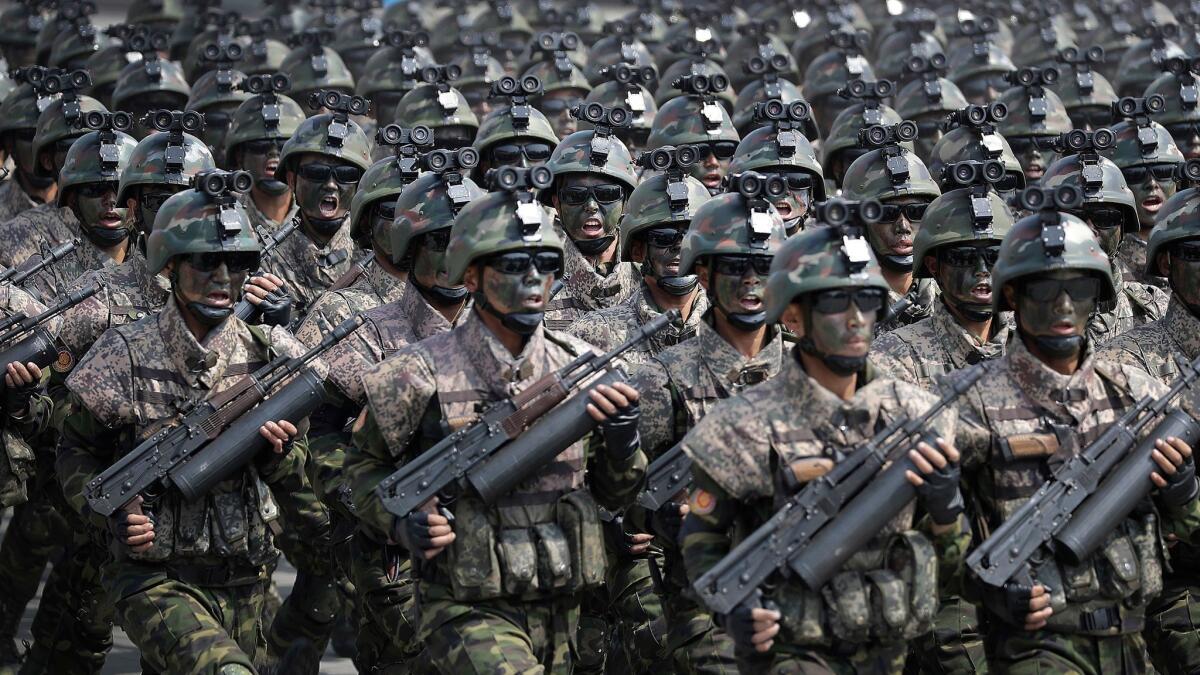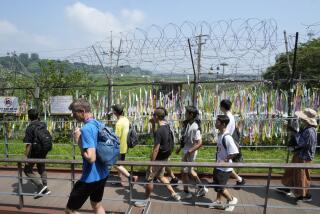Escalating tension has experts simulating a new Korean War, and the scenarios are sobering

What would happen if a war broke out between the U.S. and North Korea? (Sept. 25, 2017)
This is the way a nuclear war begins.
Simulations of a war on the Korean peninsula usually start with a relatively minor incident at the demilitarized zone between South Korea and its hostile northern neighbor, or a provocation that develops into a conventional war and then escalates.
President Trump’s threatening posture toward North Korea — most recently exhibited at the United Nations, where he warned that the U.S. could “totally destroy” the country — has prompted military strategists to examine what would actually happen if a war broke out.
The scenarios are a sobering corrective to the notion that North Korea’s nuclear capacity could be taken out in a single strike, or that the regime would prove as fragile as that of Saddam Hussein in Iraq or Moammar Kadafi in Libya.
“Too many Americans have the view that it would be like the invasion of Iraq or Afghanistan, or like combat operations in Libya or Syria, but it wouldn’t remotely resemble that,’’ said Rob Givens, a retired Air Force brigadier general who spent four years stationed on the Korean peninsula.
And that is before the North Koreans turn to nuclear weapons. “There is only one way that this war ends,” Givens said. “With North Korea’s defeat — but at what cost?”
James Stavridis, a retired Navy admiral and dean of the Fletcher School of Law and Diplomacy at Tufts University, said the horrific war many have long feared with North Korea is a distinct possibility. He puts the chances of conventional conflict with North Korea at 50-50 and the chances of nuclear war at 10%.
“We are closer to a nuclear exchange than we have been at any time in the world’s history with the single exception of the Cuban missile crisis,’’ Stavridis said.
The conflict that Stavridis envisions might start with North Korean leader Kim Jong Un launching a missile that lands on or near Guam.
The United States then moves aircraft carrier strike groups within range of the peninsula and retaliates with an airstrike on a coastal launch facility, perhaps using a Tomahawk cruise missile — similar to the attack the U.S. launched to punish Syria for its use of chemical weapons.
The strike is intended as a message, not an invitation to all-out war. But Kim, unlike Syria’s Bashar Assad, is unlikely to sit idly by.
“He has to react. He knows that if there is a military strike and he does nothing about it, they’ve called his bluff and the game is all over for him,’’ said Sue Mi Terry, a former CIA analyst on North Korea.
North Korea might respond by lobbing a few artillery shells toward the 35,000 U.S. troops currently stationed in South Korea.
North Korea has approximately 11,000 conventional artillery pieces dug into the mountains north of the demilitarized zone. Although much of the equipment dates from the Soviet era, it is in excellent working order and well-protected from drone strikes and airstrikes because it is designed to be rolled in and out from tunnels in the mountains.
The United States would try to take out the artillery with drones and airstrikes, but that would take days, in which time the North Koreans would probably launch a punishing barrage aimed at Seoul and its population of 25 million.
As the war escalates, the North Koreans would likely bomb the bridges across Seoul’s Han River to make it more difficult for civilians to flee, use special forces and infiltrators to attack key facilities and personnel in South Korea, and launch short-range missiles against South Korean and U.S. military bases.
The Pentagon has estimated the potential number of dead in South Korea at 20,000 each day, Givens said. And that is before the North Koreans turn to nuclear weapons.
Although North Korea has successfully tested an intercontinental ballistic missile and conducted six nuclear tests, the technologies have not yet been married together. That means that though the West Coast of the U.S. now appears to be within range of North Korea’s missiles, it is unlikely that Pyongyang could credibly target the mainland United States with a fully functioning nuclear weapon at this stage.
On the other hand, a nuclear device could be smuggled into a container port or dropped from an airplane, perhaps near one of the U.S. bases in Asia.
“In an all-out conquest for regime survival, they will come after the United States. They are not going to win, but they will try — I guarantee that,’’ Givens said.
The paradox with North Korea is that its weakness is what makes it so dangerous — and why it is difficult to make comparisons with the Cold War period, when fears of mutually assured destruction deterred war with the Soviet Union.
If Kim thinks his regime is collapsing, many of those who have long studied the inscrutable leader believe, he would be inclined to reach for the nuclear option in order to take down everyone else with him — a last lash of the dragon’s tail.
“The North Koreans are in a weak position. They can’t sustain a protracted conventional war. They would have to reach for their weapons of mass destruction early on,’’ said Daniel Pinkston, a former military translator who now teaches defense strategy in South Korea.
The very notion of trying to take out North Korea’s nuclear weapons, he added, “has a high likelihood that you are going to unleash the very thing that you are trying to prevent.’’
Kim Jong Il, father of the current leader, is widely reported to have said, “I would destroy the world or take the world with me before accepting defeat on the battlefield.”
The oft-cited statistics about North Korea’s military are formidable: 1.2 million soldiers in the fourth-largest ground army in the world, among them more than 100,000 special forces trained to infiltrate South Korea. Although its military hardware dates back to the Soviet era, North Korea has more tanks than the United States (3,500 compared with 2,381) and more artillery pieces than China. Its nuclear fissile material is enough for least 12 nuclear weapons, possibly as many as 60, depending on their size. (According to the Arms Control Assn., the U.S. has 1,411 strategic nuclear warheads.)
“The North Korean army is still inferior in every aspect of their operations, but they have massive artillery and missile capability, very large special forces and covert operations and submarines,’’ said Anthony Cordesman of the Washington-based Center for Strategic and International Studies and author of a study of the military balance in Asia.
No doubt, a replay of the Korean War in the 21st century would be quicker than the 1950-to-1953 Korean War, a slog through snow-choked mountains that killed nearly 2 million people and left the demarcation line between North and South Korea essentially in the same place where it had started.
But despite the mechanized, high-technology weapons deployed in modern-day warfare, a new Korean War could be as drawn-out and messy as the earlier one.

“A war today would certainly involve a lot of technology, more precise and lethal systems than the last war, but you need to be very, very careful or you could be fighting in precisely those same mountains,’’ Cordesman said.
One of the unpredictable factors charting the course of a new Korean War is whether China would enter the war to save its communist ally.
The Global Times, a newspaper that often expresses Chinese government views, editorialized last month that China would not help North Korea if the U.S. retaliated against a North Korean missile attack. However, it also warned that “if the U.S. and South Korea carry out strikes and try to overthrow the North Korean regime and change the political pattern of the Korean peninsula, China will prevent them from doing so.”
Most military strategists don’t expect the current Chinese government under Xi Jinping to send its troops cross the Yalu River as Mao Tse-tung did in 1950. But Beijing could conduct airstrikes to prop up the government in Pyongyang, in much the way that Russia has come to the aid of Syria’s Assad. The Chinese also might intervene to call for a peace deal that would end up keeping Kim in power.
The aftermath of a new Korean War, even a conventional war, could be as messy as the conflict itself.
Removal of Kim could leave the country with a power vacuum and no one clearly in charge. “You might have a legitimacy competition in North Korea where different actions are backed by different parties,’’ said Scott Snyder of the Council on Foreign Relations. Although North Korea has an ethnically homogenous population — no rival ethnic factions competing for dominance — it has often been torn by regional divisions and could easily disintegrate in the way that countries such as Iraq and Libya did after the fall of dictators.
“I would not rule out the possibility that North Korea’s future could look a lot like Syria,’’ Snyder said. “North Korea could become a resource-consuming quagmire of many, many years.”
Twitter: @BarbaraDemick
ALSO
White House announces new travel restrictions, replacing previous ban
Worried by Pyongyang’s nuclear and missile tests, China will restrict oil exports to North Korea
More to Read
Sign up for Essential California
The most important California stories and recommendations in your inbox every morning.
You may occasionally receive promotional content from the Los Angeles Times.










